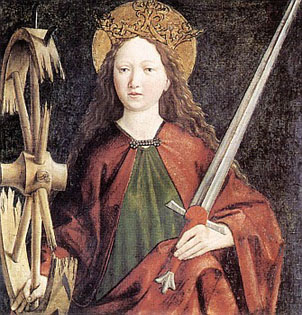| St. Catherine of Alexandria  Born: c. 3rd c. AD Born: c. 3rd c. AD
Died: c. 4th c. AD
Location of death: Alexandria, Egypt
Cause of death: Execution
Gender: Female
Religion: Roman Catholic
Race or Ethnicity: White
Occupation: Religion Nationality: Ancient Egypt
Executive summary: Patron saint of virgins and nuns Little or nothing of the history of this St. Catherine is known. The Maronite scholar, Joseph Simon Assemani (1687-1768), first identified her with the royal and wealthy lady of Alexandria who, for refusing the solicitations of the emperor Maximinus, was deprived of her property and banished. But Rufinus called this lady Dorothea, and the old Catherine legend, as recorded in the Roman martyrology and by Simeon Metaphrastes, has quite other features. According to it Catherine was the daughter of King Konetos, eighteen years old, beautiful and wise. During the persecution under Maximinus she sought an interview with the emperor, upbraided him for his cruelties, and adjured him to give up the worship of false gods. The angry tyrant, unable to refute her arguments himself, sent for pagan scholars to argue with her, but they were discomfited. Catherine was then scourged and cast into prison, and the empress was sent to reason with her; but the dauntless virgin converted not only the empress but the Roman general and his soldiers who had accompanied her. Maximinus now ordered her to be broken on the wheel; but the wheel was shattered by her touch. The headsman's axe proved more fatal, and the martyr's body was borne by angels to Mount Sinai, where Justinian I built the famous monastery in her honor. Another development of the legend is that in which, having rejected many offers of marriage, she was taken to heaven in vision and betrothed to Jesus Christ by the Virgin Mary.
Of all these marvellous incidents very little, by the universal admission of Catholic scholars, has survived the test of modern criticism. That St. Catherine actually existed there is, indeed, no evidence to disprove; and it is possible that some of the elements in her legend are due to confusion with the story of Hypatia, the neo-platonic philosopher of Alexandria, who was done to death by a Christian mob. To the men of the middle ages, in any case, St. Catherine was very real; she was ranked with the fourteen most helpful saints in heaven, and was the constant theme of preachers and of poets. Her festival was celebrated in many places with the utmost splendor, and in certain dioceses in France was a holy day of obligation as late as the beginning of the 17th century. Numberless chapels were dedicated to her, and in nearly all churches her statue was set up, the saint being represented with a wheel, her instrument of torture, and sometimes with a crown and a book. The wheel being her symbol she was the patron Saint of wheelwrights and mechanics; as the confounder of heathen sophistry she was invoked by theologians, apologists, preachers and philosophers, and was chosen as the patron saint of the university of Paris; as the most holy and illustrious of Christian virgins she became the tutelary saint of nuns and virgins generally. So late as the 16th century, Jacques Bossuet delivered a panegyric upon her, and it was the action of Dom Deforis, the Benedictine editor of his works, in criticizing the accuracy of the data on which this was based, that first discredited the legend. The saint's feast was removed from the Breviary at Paris about this time, and the devotion to St. Catherine has since lost its earlier popularity.
Canonization
Do you know something we don't?
Submit a correction or make a comment about this profile
Copyright ©2019 Soylent Communications
|